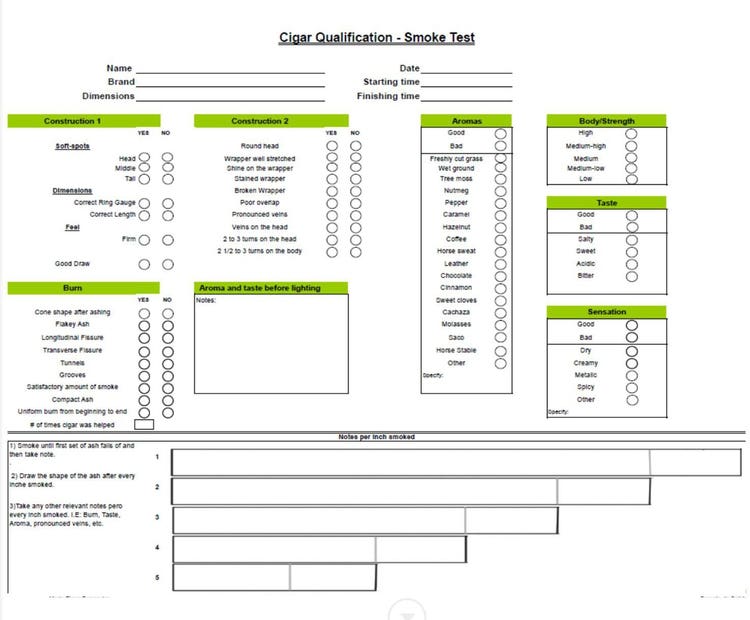
2021 CA REPORT: How to Write a Cigar Review
A primer to writing cigar reviews like a pro
Updated October 2021
Additional wisdom provided by Jared Gulick & Paul Lukens
It doesn’t take a genius to write a cigar review.
Trust me, I know a number of cigar reviewers, and that includes yours truly. As “professionals,” we Cigar Advisor writers are considered experts. Well, to a reasonable extent we are, but being professionals just means we get paid for what we do. Writing about cigars, including reviews, is a continual learning process. Even the most experienced industry pros will admit they discover something new about tobacco on a daily basis. So, don’t worry about your cigar smoking experience. What this report aims to provide is a meaningful starting point for anyone who’s ever wanted to write about the cigars they enjoy.
Let’s start with a given—reviews and cigar ratings are entirely subjective. Even so, cigar smokers like to read the opinions of other cigar smokers, especially if it’s about a cigar they smoke regularly or one they’ve wanted to try. If I see a review by another blogger for a cigar I’m also about to review, I can’t resist reading what they thought of it. If it’s a cigar that I’ve already reviewed, I can’t avoid comparing notes.

Whether you’re conscious of it or not, when you light up a cigar you’re continually reviewing it. You’re checking the draw, observing the burn, tasting the flavors, all of which add up to how much you like it—or not. Whatever your criteria, they all add up to the big question: Would you buy that cigar again?
To write a cigar review, you’ll need three things: some cigar smoking basics, an ability to distinguish flavors as they hit your palate, and a logical way to express your impressions. Remember, you’re writing an opinion, not the great American novel. Moreover, your review doesn’t have to be a published blog under a byline. It can be simply for your own amusement, a log of some kind you keep in a notebook or on your laptop. You can even make up a review worksheet with all your criteria that can be checked-off as you smoke the cigar.
Before you get started, especially if you’re going to write a cigar review for a blog, you should smoke at least two of the same cigar. One session alone will not give you or your reader a fair shake as to what the blender wanted you to experience.
* * *
How to Do a Cigar Review – The Basics
Every cigar reviewer has their own cigar rating system based on a number of key criteria. I’ll get more into detailed criteria later, but for now here are the basics with a number of things to consider along with them:

Construction – How well is the cigar made? Does it have soft spots along its length. Is it rolled well? What’s the wrapper like? Upon inspection of the foot, does it look like the fill is a little loose or tight? Is the cap applied neatly, lopsided, sloppy? How many seams does it have?
Burn – Essentially, the cigar’s overall performance. Did the cigar require touching up? Did it burn unevenly or too fast? Did the cigar tunnel or canoe? Did it issue a fair amount of smoke or a thick fog?
Flavors – Is the cigar sweet, grassy, tangy, earthy, woody, bland? Describe what flavors you taste as the cigar burns. Is there a flavor that dominates the blend more than others? What those flavors are is up to you, of course, but try to get a handle on the cigar’s “flavor profile.” For more help, and to see just how many flavors are out there, see our cigar flavor wheel.

These are most of the key questions you’ll want to consider when preparing your review. You may even come up with a few more of your own.
The Details on How Cigars Are Rated
Once you have a handle on the cigar’s basics, there’s a lot more you can tell the reader about it. The amount of detail you want to convey is your choice, but there are some things that should not go without stating.
Always include the blend information. If you don’t know it, you can usually find it by going to the cigar brand’s website, searching for the press release, or checking CigarAdvisor.com to see if we reviewed it. Start with the following format:
Country of origin:
Size: (length x ring gauge)
Strength:
Wrapper:
Binder:
Filler:
Almost all cigar reviews start with construction, but in addition to the burn and flavors, you’ll also want to include the following criteria:

Finish – After each puff, what flavors remain on your palate?
Aroma – Does the smoke smell sweet, earthy, burly, sharp, grassy, etc.?
Ash Quality – This could go under “Burn,” but describe the ash’s firmness, color/s, shape, etc.
Balance – Are the flavors all working in sync, or do one or more flavors stand out?
Complexity – Do new flavors enter the mix as the cigar burns? Do the flavors switch-up at several instances during your session? Do the strength and/or body change along the way? If so, how? (Note that complexity can also be subjective.)
Writing Your Cigar Review
Again, depending on the length or type of review you’re writing, you can simply list the criteria above followed by short sentences, or you can describe your entire cigar experience as you smoked the cigar as follows.
A lot of cigar reviews break the cigar into three sections. I like to use the term “acts,” because for me it’s a performance, but you don’t have to label them at all. Sectioning is mainly a guideline to help you and the reader follow the cigar’s progress.
Write from the heart and write honestly. In other words, be yourself. Don’t try to sound snobbish or use fancy words. Don’t over complicate your review; keep it simple and easy to understand. If you taste a number of subtle flavors outside of the cigar’s general flavor profile, you can note them, but keep in mind that your readers may not taste them at all. Therefore, if you mention them, be sure to say something like, “your mileage may vary.”

And speaking of mileage, your review doesn’t have to be very long. If you want to add some interesting background or historical information on the cigar as a prelude that’s fine. If you think pairing a cigar with a particular whiskey or other drink is appropriate, toss that into the mix. Ideally, you should be able to sum it all up in around 500 words. Admittedly, I sometimes go overboard.
Don’t gush over the cigar. (I plead guilty to this occasionally, too.) You can write a very positive review without sounding like you work for the brand. You’re supposed to be a little objective, too. Jared has a good take on this below, too.
On the other hand, if you didn’t like the cigar try to be diplomatic. Don’t bash the brand or the blender. This is another reason you should smoke at least two of the same cigar. You’d be surprised how often the second cigar is better than the first.
Pictures Illustrate Your Review
Be sure to include pictures of the cigars you review. Take a shot of the cigar before you light it followed by pix of each section, including the nub if you get that far. If the cigar has a great ash, get a shot of that, too. But don’t overload your review with an entire wedding album of photos. Using captions can also be helpful.

“Should I add a cigar rating score to my review?”
Great question. Even though we don’t use numbered cigar ratings on Cigar Advisor, cigar rating scores with ranges like one to four stars, or zero to 100 can be helpful in giving the reader a quick, drive-by look at the cigar’s performance. Yet one reviewer’s 90 may be another’s 80. I know a reviewer who scores each section of the cigar and totals it up at the end. As Paul describes below, rather than using numbers, you can “assign weights” to your criteria.
* * *
Whether you plan on writing your cigar review or doing it on video, keep it organized, state your impressions in an honest way, don’t let it drag on, and very important—give your reader something they can take away from it.
Two More Approaches to Writing a Cigar Review

By Paul Lukens
OK, the first thing I need to say is take the following with a box of salt. After all, who am I? I don’t have a teaching degree from the International Institute of Cigar Reviewers and that’s why I don’t dish out grades. I’m just like you—a guy who likes cigars and holds opinions.
I’ve spent some time thinking about what I value in a cigar. Basically, what do I look for in a great smoke, one that I’ll always have on hand? I’ve narrowed it down to a list of 5 basic principles—all subjective, but adaptable to individual interpretations (i.e., you might think of ‘balance’ differently).
I consider a cigar based on 5 elements:
If a cigar hits on all 5—it’s great in my book. If a cigar hits on 4 of 5 it’s very good, 3 of 5 good, and so forth. While I refrain from giving ratings—you can do this by assigning weights to each category. And while it’s nice to give categories—they’re subjective. Here’s what they mean to me: Balance means that no one flavor dominates the others. Complexity is a multitude of flavors in balance (non-clashing, non-dominating). Ability to age is self-explanatory, as is, how it tastes to me. Nuance is the Gordian knot, and I’ll explain it by saying you know it when it’s present. And while not comprehensive, these categories give me a good framework in how I think about a cigar.

By Jared Gulick
I think the biggest problem with today’s cigar reviewing elite (not naming names) is that so many of them act as if smoking a cigar is supposed to be esoteric; or worse, they think each review is somehow about them, as if what they personally like or love is the gold standard.
As counterintuitive as it might seem with reviews being based on an author’s opinion, the reviewing process itself should never be about the author. It’s really about the smoker on the other end who’s looking to get – or even avoid – something specific from a cigar they were interested in enough to research further. The information they find should be easy to understand, even if they’ve never smoked a cigar before.
Most importantly, you should never decide whether the cigar is ‘good’ or ‘bad.’ You’ve got to toss your ego out of the equation and realize that your palate doesn’t speak for everyone. Just give your audience a few basics: the flavors you picked up, a little of what you liked, and a little of what you didn’t along with what type of smoker you think will enjoy the cigar in question the most. Be honest and you’ll leave your readers not only with your trust, but also the tools to make up their own minds.